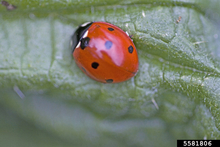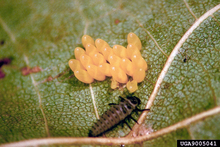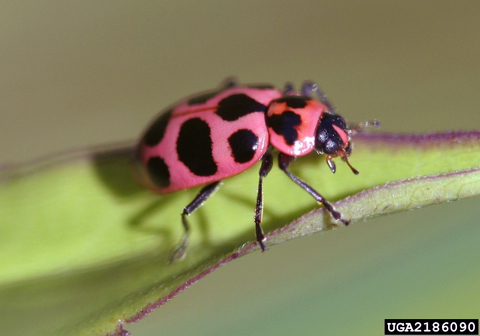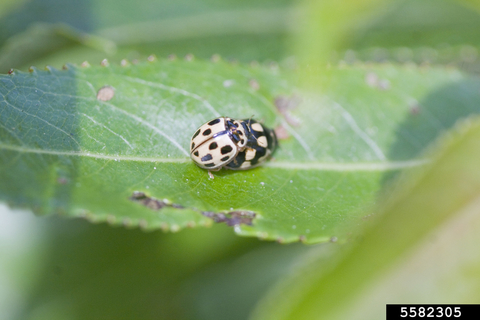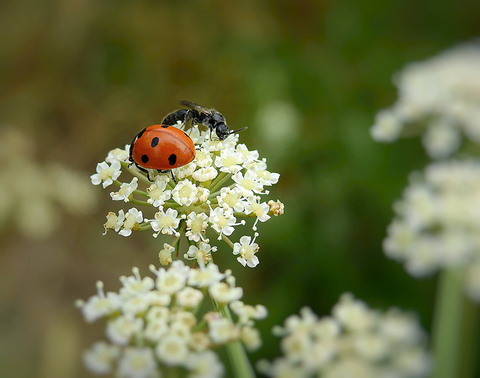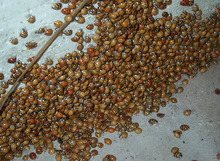Quick facts
- Minnesota is home to more than 50 species of native lady beetles (also known as ladybugs or ladybird beetles), as well as introduced lady beetle species.
- All lady beetles eat insects, as well as nectar and pollen, making them beneficial insects.
- Some species of lady beetles are a nuisance when they enter buildings as the weather cools in the fall.
- Lady beetles can be drawn into an area by planting a variety of flowering plants.
How to tell lady beetles from other insects
Lady beetles have a lifecycle like a butterfly, where there are four distinct forms depending on how old the insect is. Both the adults and larvae eat insects, in fact, larvae eat more pests than adults do.
Being able to identify all life stages can help you identify and protect these beneficial insects.
Adults
- Most adult lady beetles have domed, hard, round to oval bodies.
- Many species are red with black spots, but there are species that are predominately black, yellow, pink, and orange.
- Beetles are active, moving around plants looking for food and taking flight if disturbed.
- If handled, beetles may produce a bad-smelling defensive liquid.
Larvae
- Larvae do not resemble adults.
- Larvae have long bodies, which taper at the back end.
- From above they do not have a clear head and six distinct legs.
- They are generally black with areas of white, orange, or red.
- Some species have pointed bumps or spines.
- The larval life stage lasts 2-3 weeks.
Eggs
- Eggs are yellow, orange or red and laid in groups of 5-30.
- Individual eggs are an elongated oval shape.
- They are most often found on plants where there are aphids, mealybugs or scale insects.
Pupae
- Pupae may be spotted on leaves, bark or plant stems.
- Pupae are orange to red with black spots, with a shriveled appearance. They turn a darker color as a beetle readies itself to emerge.
- Pupae are immobile, though they may wiggle if disturbed.
Biology
Different species of ladybugs have different specifics in their life cycle, but there is a lot of overlap across species.
- Most lady beetle species spend the winter in piles of leaves, bark, dead trees, or in buildings. They can be found clustered together in groups.
- Adults emerge in the spring and lay eggs on plants where their insect prey is present.
- Eggs hatch and larvae feed on small, soft-bodied insects.
- Larvae pupate on plants. The pupa stage lasts 1-2 weeks.
- Adults emerge from the pupa and search for food, sometimes flying great distances.
- There are multiple generations per year, so seeing any life stage at any point in the summer is possible.
Promoting lady beetles in garden and farms
To support lady beetles in your yard, garden, or farm, think about ways to provide them with a variety of food and habitat.
- Have consistently flowering plants in your space. Lady beetles especially like shallow flowers, such as alyssum, coriander and dill.
- Leave some brush or leaves in your outdoor space for lady beetles to spend the winter in.
- Allow some amount of aphids to be on plants.
- Limit pesticide applications. Many insecticides are not selective, meaning they will kill both pests, beneficial insects, and other insects. If you plan on using an insecticide, look for a selective insecticide that will not kill lady beetles.
Is it worth buying lady beetles to manage pests?
It is possible to buy lady beetles online or from garden magazines for pest control purposes. Because lady beetles can fly, they are highly mobile. This means that just because you release them in your farm or garden, it doesn’t mean they will hang around and feed on pests.
If you are thinking about purchasing lady beetles, think about the following:
- Could lady beetles control your problem? Lady beetles are best for controlling small, soft-bodied insects like aphids. If you aren’t sure what is wrong with your plant, Ask a Master Gardener for help figuring out what the problem could be.
- How big is your problem? Research has suggested that it can take multiple releases of thousands of lady beetles to control large aphid outbreaks.
- Can you correctly handle the lady beetles? Beetles will need to be shipped promptly and kept cool until you are ready to release them. They will likely need water immediately after they are released.
- Are these pest issues recurring? Research suggests that almost all lady beetles released into the garden leave after a few days. Because of the times when lady beetles are collected for sale, it can take weeks before they lay eggs. If your pest issue is a large and recurring issue, look for a more long-term solution.
It is more sustainable in the long term to make your yard, garden, or farm more welcoming to lady beetles and other beneficial insects than it is to buy lady beetles.
Dealing with lady beetles as a pest
The most common lady beetle in Minnesota, the multicolored Asian lady beetle, is a nuisance pest in the fall and spring. They often try to spend the winter in buildings, gathering in large numbers.
Cranshaw, W. (2016, April 15). Lady beetles. Retrieved November 15, 2021, from https://extension.colostate.edu/topic-areas/insects/lady-beetles-5-594/
Cranshaw, W. &; Shetlar, D. J. (2018). Garden Insects of North America: The Ultimate Guide to Backyard Bugs. Princeton University Press.
Flint, M. (2014, May 14). Ladybugs need special care to control aphids in the garden. ANR Blogs. https://ucanr.edu/blogs/blogcore/postdetail.cfm?postnum=13933
Reviewed in 2022


